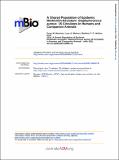Files in this item
A shared population of epidemic methicillin-resistant Staphylococcus aureus 15 circulates in humans and companion animals
Item metadata
| dc.contributor.author | Harrison, Ewan M | |
| dc.contributor.author | Weinert, Lucy A | |
| dc.contributor.author | Holden, Matthew T G | |
| dc.contributor.author | Welch, John J | |
| dc.contributor.author | Wilson, Katherine | |
| dc.contributor.author | Morgan, Fiona J E | |
| dc.contributor.author | Harris, Simon R | |
| dc.contributor.author | Loeffler, Anette | |
| dc.contributor.author | Boag, Amanda K | |
| dc.contributor.author | Peacock, Sharon J | |
| dc.contributor.author | Paterson, Gavin K | |
| dc.contributor.author | Waller, Andrew S | |
| dc.contributor.author | Parkhill, Julian | |
| dc.contributor.author | Holmes, Mark A | |
| dc.date.accessioned | 2014-07-08T11:01:05Z | |
| dc.date.available | 2014-07-08T11:01:05Z | |
| dc.date.issued | 2014-05-13 | |
| dc.identifier | 119787530 | |
| dc.identifier | b795e678-29a8-4a1d-b807-a0b9d2e9b217 | |
| dc.identifier | 24825010 | |
| dc.identifier | 84903973634 | |
| dc.identifier.citation | Harrison , E M , Weinert , L A , Holden , M T G , Welch , J J , Wilson , K , Morgan , F J E , Harris , S R , Loeffler , A , Boag , A K , Peacock , S J , Paterson , G K , Waller , A S , Parkhill , J & Holmes , M A 2014 , ' A shared population of epidemic methicillin-resistant Staphylococcus aureus 15 circulates in humans and companion animals ' , mBio , vol. 5 , no. 3 , e00985-13 . https://doi.org/10.1128/mBio.00985-13 | en |
| dc.identifier.issn | 2150-7511 | |
| dc.identifier.other | ORCID: /0000-0002-4958-2166/work/60196455 | |
| dc.identifier.uri | https://hdl.handle.net/10023/4967 | |
| dc.description | This work was supported by a Medical Research Council Partnership grant (G1001787/1) held between the Department of Veterinary Medicine, University of Cambridge (M.A.H.), the School of Clinical Medicine, University of Cambridge (S.J.P.), the Moredun Research Institute, and the Wellcome Trust Sanger Institute (J.P. and S.J.P). S.J.P. receives support from the NIHR Cambridge Biomedical Research Centre. M.T.G.H., S.R.H. and J.P. were funded by Wellcome Trust grant no. 098051. | en |
| dc.description.abstract | Methicillin-resistant Staphylococcus aureus (MRSA) is a global human health problem causing infections in both hospitals and the community. Companion animals, such as cats, dogs, and horses, are also frequently colonized by MRSA and can become infected. We sequenced the genomes of 46 multilocus sequence type (ST) 22 MRSA isolates from cats and dogs in the United Kingdom and compared these to an extensive population framework of human isolates from the same lineage. Phylogenomic analyses showed that all companion animal isolates were interspersed throughout the epidemic MRSA-15 (EMRSA-15) pandemic clade and clustered with human isolates from the United Kingdom, with human isolates basal to those from companion animals, suggesting a human source for isolates infecting companion animals. A number of isolates from the same veterinary hospital clustered together, suggesting that as in human hospitals, EMRSA-15 isolates are readily transmitted in the veterinary hospital setting. Genome-wide association analysis did not identify any host-specific single nucleotide polymorphisms (SNPs) or virulence factors. However, isolates from companion animals were significantly less likely to harbor a plasmid encoding erythromycin resistance. When this plasmid was present in animal-associated isolates, it was more likely to contain mutations mediating resistance to clindamycin. This finding is consistent with the low levels of erythromycin and high levels of clindamycin used in veterinary medicine in the United Kingdom. This study furthers the "one health" view of infectious diseases that the pathogen pool of human and animal populations are intrinsically linked and provides evidence that antibiotic usage in animal medicine is shaping the population of a major human pathogen. | |
| dc.format.extent | 10 | |
| dc.format.extent | 5595527 | |
| dc.language.iso | eng | |
| dc.relation.ispartof | mBio | en |
| dc.subject | QR Microbiology | en |
| dc.subject | SDG 3 - Good Health and Well-being | en |
| dc.subject.lcc | QR | en |
| dc.title | A shared population of epidemic methicillin-resistant Staphylococcus aureus 15 circulates in humans and companion animals | en |
| dc.type | Journal article | en |
| dc.contributor.institution | University of St Andrews. School of Medicine | en |
| dc.contributor.institution | University of St Andrews. Infection Group | en |
| dc.contributor.institution | University of St Andrews. Biomedical Sciences Research Complex | en |
| dc.identifier.doi | https://doi.org/10.1128/mBio.00985-13 | |
| dc.description.status | Peer reviewed | en |
This item appears in the following Collection(s)
Items in the St Andrews Research Repository are protected by copyright, with all rights reserved, unless otherwise indicated.

